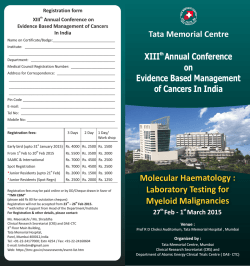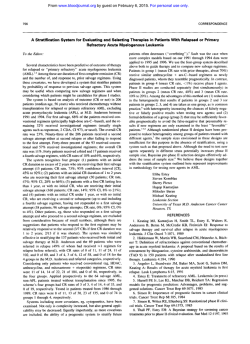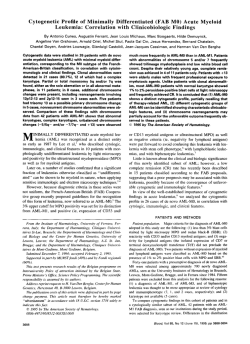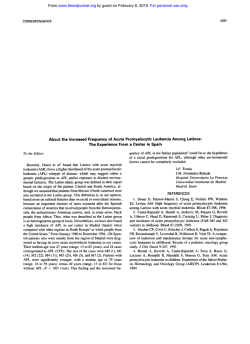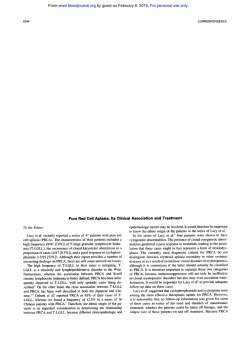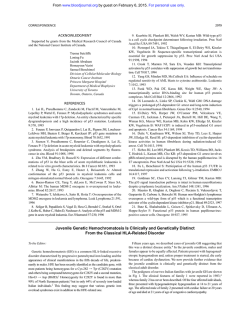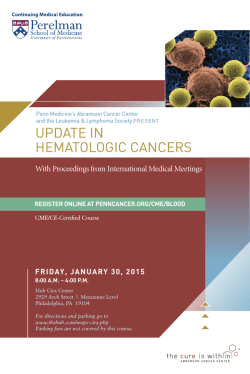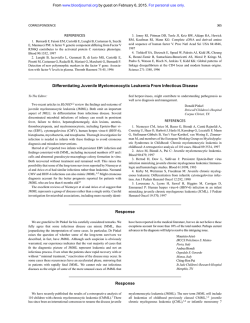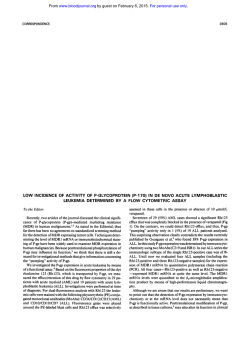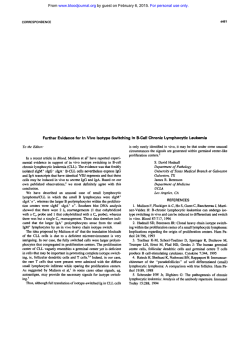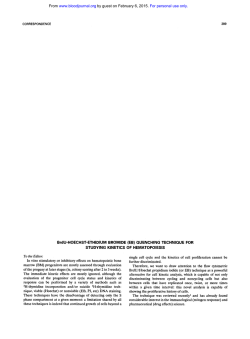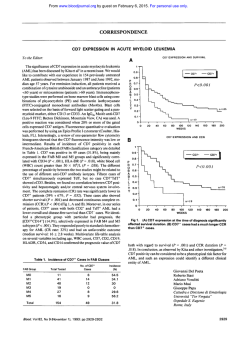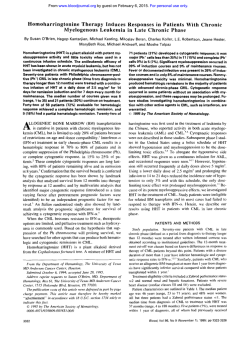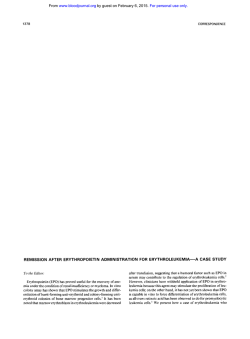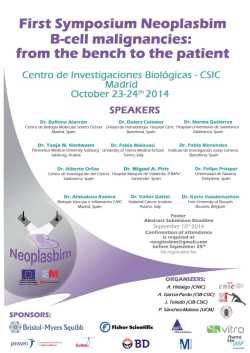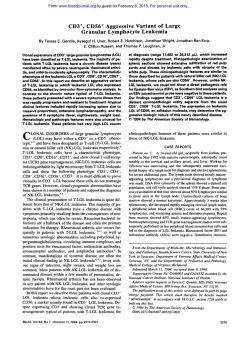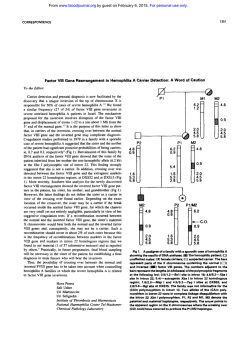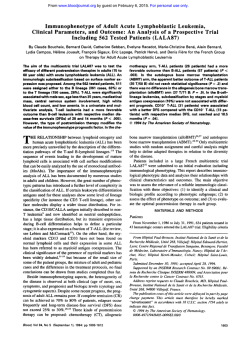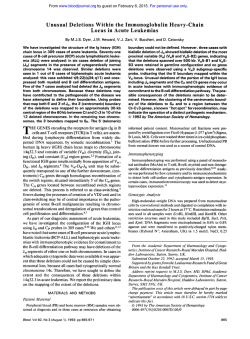
Differences in the Chromosomal Profile of AML-MO Versus
From www.bloodjournal.org by guest on February 6, 2015. For personal use only. 5381 CORRESPONDENCE Differences in the Chromosomal Profile of AML-MO Versus AML-M1: Response To the Editor: In our study published in Blood in 1995, 26 patients with minimally differentiated acute myeloid leukemia (AML-MO) were shown to have a different cytogenetic profile with respect to 42 patients with AML-M1. The observed high incidence of complex karyotypes and of unfavorable chromosome changes such as -5/5q-, -7/7q-, and + 13 in AML-MO may provide a biologic argument partially explaining the poor prognosis of this newly recognized entity of leukemia.’ The study by Venditti et a12 in the January l, 1996 issue of Blood confirms that AML-MO has an unfavorable prognosis. However, these investigators describe similar cytogenetic features in AML-MO and AML-MI, which is at variance with our results. We wish to analyze three possible factors, concerning (1) patient selection, (2) influence of environmental exposure to myelotoxic agents, and (3) statistical analysis, that may account for the discrepant cytogenetic findings in these studies. Twenty-six patients were selected in our analysis from approximately 700 newly diagnosed patients seen in Ferrara, Italy and in 4 Belgian Institutions. Fifteen additional patients with presumptive diagnosis of AML-MO were excluded at centralized cytoimmunologic review.’ Thus, the incidence ofAML-MO in our multicenter study is 3.7%. There is a very high incidence of AML-MOand AMLM1 in the study by Venditti et a l z (8.9% and 19.5%, respectively, in 256 AMLs), as compared with previous studies. The incidence of AML-MO in 2 large series, totalling over 1,300 AML cases, ranged between 0.1% and 4%3.4;likewise, a 16.4% and 10% incidence of AML-M1 was recorded in the large GIMEMAEORTC trial and in the GIMEMA study of 355 AML patients submitted to centralized cytologic The patients of Venditti et alz with AML-M1 also have a higher incidence of chromosome changes (75%) than was previously reported in 97 cases of de novo AML-MI studied at the Fourth International Workshop on Chromosomes in Leukemia (40.2%): It is worth noting that comparative analyses of original French-American-British (FAB) diagnoses and reviewers’ diagnoses in the GIMEMAEORTC group showed that the most frequent disagreement (30% of total) was confined to those cases classified as AML-M1 by refemng centers and recognized either as AML-M2 or AML with monocytic features at centralized review.’,’ The incidence of chromosome changes varies according to the FAB type and, therefore, homogeneous application of the FAB scheme is of critical importance for studies comparing cytogenetic and cytologic features. Exposure to myelotoxic agents may also influence the rate of chromosome abnormalities in leukemia. For instance, professional exposure to organic solvents, petroleum products, or pesticides was recorded frequently in our cases with complex karyotypes and with +13. In the study by Venditti et a1: data from only 28 of 50 observed AML-M1 are used for cytogenetic comparison with AML-MO and criteria for patient selection are not mentioned. The number of observed cases in the different cytogenetic groups (-51-7, f13, +8, +4,others, and normal) do not add upto the total number of patients studied. The difference of patient distribution in three cytogenetic categories (complex karyotype, abnormal with 1 or 2 changes, and normal karyotype) in AML-MO versus AML-M1 approaches statistical significance (P= .09). We agree with Venditti et alz that reagents detecting myeloperoxidase are useful in the immunologic recognition ofAML-MO; however, the importance and the exact role of this and other markers (CD1 17 and antilysozyme) in the diagnosis of acute leukemia is currently being tested in a prospective European study.8 Antonio Cuneo Gianluigi Castoldi Institute of Hematology University of Ferrara Ferrara, Italy Jean-Louis Michaux Augustine Ferrant Bernard Chatelain Departments of Hematotogy U.C.L. of Brussels and Mont-Godinne Belgium Andries Louwagie Department of Hematology A.Z. St Jan Brugge, Belgium Marc Boogaerts Paola Dal Cin Herman Van den Berghe Institute of Hematology and Centre for Human Genetics University of Leuven Leuven, Belgium REFERENCES 1. Cuneo A, Ferrant A, Michaux L,Boogaerts M, Demuynck H, Van Orshoven A, Criel A, Stul M, Dal Cin P, Hernandez J, From www.bloodjournal.org by guest on February 6, 2015. For personal use only. 5382 Chatelain B, Doyen C, Louwagie A, Castoldi GL, Cassiman JJ, Van Den Berghe H: Cytogenetic profile of minimally differentiated (FAB-MO) acute myeloid leukemia: Correlation with clinicobiologic findings. Blood 85:3688, 1995 2. Venditti A, Del Poeta G , Stasi R, Buccisano F, Aronica G , Bruno A, Cox C, Maffei L, Tamburini A,Papa G , Amadori S: Biological profile of 23 cases of minimally differentiated acute myeloid leukemia (AML-MO)and its clinical implications. Blood 87:418, 1996 3. Zittoun R,Mandelli F, Willemze R, de Witte T, Labar B, Rese gotti L, Leoni F, Damasio E, Visani G , Papa G, Caronia F, Hayat M, Stryckmans P, Rotoli B, Leoni P, Peetermans ME, Dardenne M, Vegna ML, Petti MC, Solbu S, Suciu S, the European Organization for Research and Treatment of Cancer (EORTC) and the Gruppo Italian0 Malattie Ematologiche Maligne dell’Adulto (GIMEMA) Leukemia cooperative groups: Autologous or allogeneic bone marrow transplantation compared with intensive chemotherapy in acute myelogenous leukemia. N Engl J Med 332:217, 1995 CORRESPONDENCE 4. Bennett JM, Catovsky D, Daniel MT, Flandrin G , Galton DAG, Gralnick HR. Sultan C: Proposals for the recognition of minimally differentiated acute myeloid leukaemia. Br J Haematol 78:325, 1991 5 . Castoldi GL, Lis0 V, Fenu S, Vegna ML, Mandelli F Reproducibility of the morphological diagnostic criteria for acute myeloid leukemia: The GIMEMA group experience. Ann Hematol 66: 171, 1993 6. Fourth International Workshop on Chromosomes in Leukemia: Overview of association between chromosome pattern and cell morphology, age, sex and race. Cancer Genet Cytogenet 11:265, 1984 7. Castoldi GL, Cuneo A, Lanza F, Rigolin GM: Cytology and phenotype of leukaemia. Proceedings of the 1st European Forum on Leukemias. European School of Oncology. Bergamo, Italy, September 5-8, 1994 8. Bene’ MC, Castoldi GL, Knapp W, Ludwig WD, Matutes E, Orfao A, van’t Veer MB, The European Group for the Immunological Characterization of Leukemias (EGIL): Proposals for the immunological classification of acute leukemias. Leukemia 9:1783, 1995 From www.bloodjournal.org by guest on February 6, 2015. For personal use only. 1996 87: 5381-5382 Differences in the chromosomal profile of AML-M0 versus AML-M1: response [letter; comment] [see comments] A Cuneo, G Castoldi, JL Michaux, A Ferrant, B Chatelain, A Louwagie, AZ St Jan, M Boogaerts, PD Cin and H Van den Berghe Updated information and services can be found at: http://www.bloodjournal.org/content/87/12/5381.citation.full.html Articles on similar topics can be found in the following Blood collections Information about reproducing this article in parts or in its entirety may be found online at: http://www.bloodjournal.org/site/misc/rights.xhtml#repub_requests Information about ordering reprints may be found online at: http://www.bloodjournal.org/site/misc/rights.xhtml#reprints Information about subscriptions and ASH membership may be found online at: http://www.bloodjournal.org/site/subscriptions/index.xhtml Blood (print ISSN 0006-4971, online ISSN 1528-0020), is published weekly by the American Society of Hematology, 2021 L St, NW, Suite 900, Washington DC 20036. Copyright 2011 by The American Society of Hematology; all rights reserved.
© Copyright 2026


